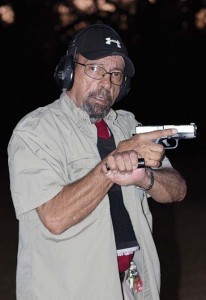by TGM staff
Accidents and injuries at shooting ranges have decreased over the years, thanks in large part to the efforts of instructors, range officers and other training and competition staffers aiming to increase awareness of guns and gun safety.

Renowned veteran self-defense expert and shooting instructor Massad Ayoob is shown here wearing an Armor Express ballistic vest while teaching night shooting. Ayoob is not the only shooting instructor in TGM staff’s acquaintance who does wear a vest whenever it seems appropriate.
It is also due to increased protection in the form of body armor worn by people frequently exposed to new or little known shooters; after all accidents do sadly still occur.
There are a number of ways safety can be improved on shooting ranges; a key example is having clear start and finish periods to any shooting. However, instructors are already well aware of how best to safely operate a range, but may not be aware of the accessible protection available to them in the form of body armor. Choosing a vest that suits your needs and is capable of protecting you against the firearms that surround you is a simple step in preventing tragedy.
There are different levels of protection available in body armor, and it is important that the armor you choose is capable of protecting against the most likely threats. For example, it is recommended that Law Enforcement Officers have bullet resistant vests that can protect against the ammunition used in their own firearms. This is in view of the unlikely (but still serious) possibility that their weapon is taken and used against them. However, shooting range instructors will need protection against any and all ammunition that can be used on the range.
This will include handguns, for which a vest at Level IIIa will be necessary. These are capable of protecting against the vast majority of ammunition used in handguns, including 9mm, .45mm, .22m and .44 Magnums. However, if higher caliber rounds are used on the range, they will need to be able to protect against them. No matter how unlikely it seems, accidents can and do happen, and to protect against the ammunition used in rifles and automatics you will need a vest at Level III or IV.
As well as deciding on the most appropriate level of protection, it is important to decide on the style of armor you will be wearing. While the higher levels of protection will increase the size and weight, the difference is negligible, and even vests at Level IV can be worn in a covert style. Covert armor is designed to be worn underneath clothing, and is useful when you do not wish to display your protection. It may be that you wish to hide your armor, perhaps to avoid potentially unnerving customers or members of the public. These covert armors can even incorporate temperature-regulating technologies to help keep you cool and draw moisture away from the skin.
Most instructors and range personnel are aware of how hot some shooting ranges can become, and when you are wearing armor constantly—as you should when firearms are a continuous presence, it needs to be as comfortable as possible.
Many professional instructors already wear body armor either at all times when on the range, or at least when working with shooters who are new to them, or for low light or no-light shooting scenarios.
Of course, armor at any level can be worn in an overt style as well, meaning that it is worn over clothing. This can be useful for instructors that perhaps wear a uniform, as overt vests can be augmented with logos and insignia, making them a useful part of a uniform. Similarly, overt armor will further exert your authority and help you remain in constant control. Body armor can be an expensive investment, particularly if you find yourself needing hard body armor with rigid plates. Prices range from around $200 for the lowest levels of body armor, to over $1000 for rigid tactical armor. However, for most shooting instructors the average price for a vest is around $350-$600, depending on features and manufacturer. This is, of course, still a large investment, and this is why it is so important that you understand exactly how body armor works in order to make sure you are properly protected.
You can do more research about body armor vests on the web or visit a local police supply or shooting equipment store for more information. However, bear in mind; it’s a one-time investment in insurance.



